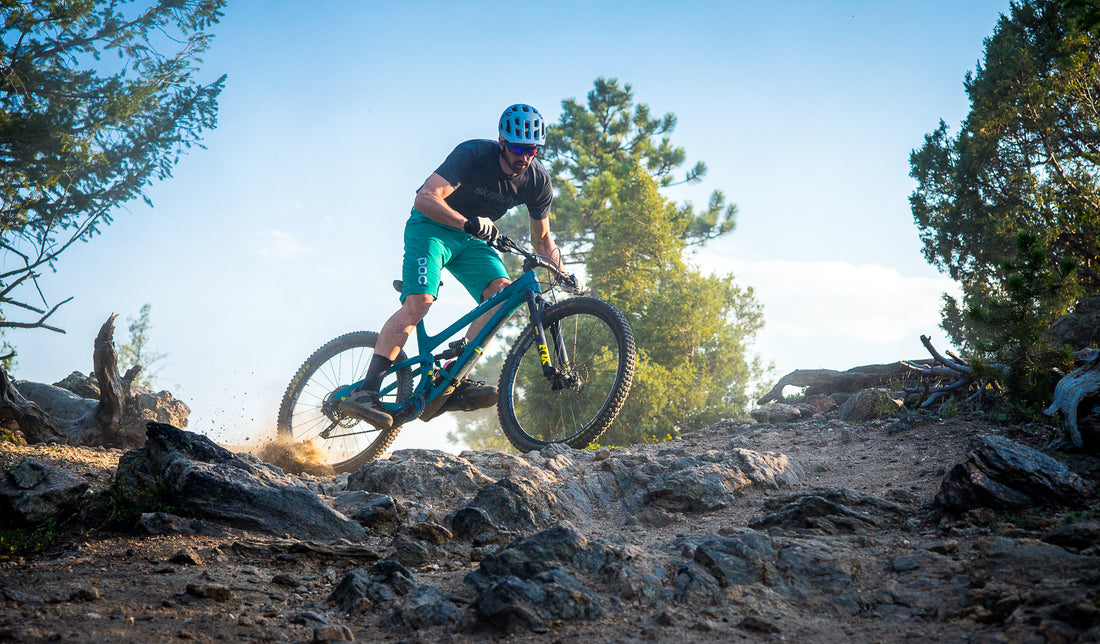As with any component on your bike, you have many options to choose from when determining what brake rotor to buy and install. Some come in different colors, others have small cutouts or large ones, and some have varying thicknesses. The two main variations you’ll find though are in the size of the rotor and its construction.
A larger rotor allows your brakes to have more leverage, therefore needing less force to brake at a given pressure. To you, the rider, this makes the brakes feel more powerful. Common choices are 160mm, 180mm and 203mm diameters, with some brands making rotors up to 246mm.
The other variation is the construction of the brake rotor itself. Most standard brake rotors are called ‘fixed’ while another style, a ‘floating’ rotor, is considered a higher performance option.
Purpose of the Rotor
Before we get into the difference between floating versus fixed rotors, it’s important to understand the rotors' job. While the brake pads take the brunt of braking duties, the rotors play an important role.
When you squeeze your brakes, your brake pads clamp down on the rotors. This creates friction, and the energy of you moving forward is turned into heat from that friction. The rotor then has two jobs: to provide a surface on which to create that friction and to help get rid of the heat being generated.
The rotor also has to remain structurally sound and must be made of a harder material than your brake pads, hence why brake rotors are steel. Steel provides a good balance of durability and weight. Using iron, like a car’s brake rotor, would be much too heavy!
Floating Brake Rotors
What is a Floating Brake Rotor
On a floating brake rotor the outer braking surface and the internal carrier are two individual parts that are attached together with rivets, oftentimes with a slight gap between the two. Because of this gap, the braking surface ‘floats’ above the hub carrier, giving it its name.
One of the main benefits of a floating rotor is heat management, and more specifically the prevention of warping. Warping occurs when there is a difference between the temperature of the outside of the rotor (the braking surface) and the inside (closest to the hub). On a standard rotor that can cause the edges to curl inwards towards each other. With a floating rotor, those differences are nullified as the outer and inner elements of the rotor are no longer connected.
The hot braking surface has a gap between itself and the hub carrier and it is allowed to expand independently. The reason this outer element doesn’t warp is due to it being able to heat up and expand uniformly and experience the same temperature across its entire surface.
With a true floating rotor, you’ll hear it pinging as it cools, sounding much like a spoke settling on a newly built wheel.
Within the mountain biking world there are some variations of the floating rotor. Some brake rotors are true floating rotors, while others are simply 2-piece rotors with the braking surface and hub carrier pinned rigidly together. A 2-piece rotor can still provide the benefit of lower weight and better heat management, but there is no gap between the braking surface and the hub carrier.
Floating Brake Rotor Benefits
- Better heat management - Less heat is transferred from the braking surface to the carrier, meaning less heat is maintained in the entire rotor. The difference in materials also helps with heat dissipation as aluminum loses heat faster than steel.
- Resistance to warping - As the braking surface is isolated from the carrier, there is less potential for warping as only the outer braking surface experiences expansion.
- Lighter weight - The carrier can be made of a different material, like aluminum, saving weight over an all-steel rotor.
Fixed Brake Rotors
What is a Fixed Brake Rotor
A fixed brake rotor is the most common style or rotor and is made of a single continuous piece of material. Most are made entirely of steel, but some manufacturers are sandwiching aluminum in-between steel for better heat management, like Shimano’s Ice-Tech rotor.
For the common steel rotor, they are simply laser-cut or stamped from a single sheet of steel, then heat treated for strength. At Miles, our rotors are laser-cut and parallel ground to ensure consistent thickness across the rotor.
Fixed Brake Rotor Benefits
- More economically priced - Creating a rotor with two materials and riveting them together creates higher costs. A solid, fixed rotor is easier to make and results in a lower cost to the end user.
What Type of Rotor Should I Get?
While floating and 2-piece rotors have their benefits, the humble fixed rotor still provides a lot of value and performance. The amount of heat required to warp a rotor is quite high, and most riders will never experience those temperatures during a normal ride. What is more likely to happen is an uneven transfer of brake pad material to the rotor, making them feel warped. A fixed rotor provides the best bang for the buck and will meet the needs of most riders.
Where floating rotors shine is on long, sustained descents with lots of braking. They’re more useful for downhill and park riders, where the brakes aren’t given much of a chance to dissipate their heat before they’re being used again. They can better cope with the stresses and rid themselves of the heat faster than a fixed rotor.


1 comment
Deberian fabricarse rotores para frenos de disco en acero templado,para evitar deformaciones,como les ocurre a los rotores corrientes, que se deforman fácilmente,no se pueden corregir las deformidades y hay que cambiarlos por nuevos, porque con el roce intermitente producen ruido y no permiten el giro libre de las ruedas.